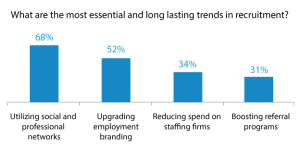Use of new technology for recruitment has been around for many years, however, there is now a seismic shift that is altering the ways of interaction between job seekers and employers. Web and smartphones together are changing the level of expectations, making recruitment systems more efficient and rewarding to use. As technology is slowly paving its way in all aspects of recruitment processes, it is reducing cost and time, and increasing overall user satisfaction. There have been many years of slack hiring, and the coming year will witness intense competition in recruitment of IT talent. As a result, recruitment teams are going to be under extreme pressure, and will have to embrace the latest technological trends to stay competitive.
Some of these latest trends have been discussed below:
Advanced Metrics– Recruitment leaders have started to follow the rest of businesses in adopting advanced metrics, and this shift to real-time metrics will enable decision makers know about the latest happenings, and predictive metrics will alert about upcoming recruitment issues and opportunities. This will give the management sufficient time to plan and act appropriately.
Career Portals– With the changing technological landscape, the expectations and long term plans of Gen Y job seekers are changing as well. They want to get accurate feel about the company, want flexible working hours, and are interested in corporate social responsibility (CSR). To cater to the needs of this generation, the career portals need to focus primarily on building a strong relationship with the candidates from the early stages. Company portals must enable the job seekers to understand their interest and competencies, and what job will make perfect sense for them in the company.

Big Data– Big data is the large volume of data available on the Web which includes forum threads, numbers, blogs, profiles, videos, pictures etc. Many employers are able to identify passive job seekers using external “Big data”. Advanced metrics developed using big data are shifting the recruiting trends towards a data-supported decision model. Smart organizations are using technology to track the online journey of a candidate, such as pages viewed and jobs applied for.
Go Mobile– Mobile phones allow direct application for jobs, and this will become more popular as more and more recruitment-focused mobile apps are being developed. The Mobile Web Watch report by Accenture shows that more than 85% of the people access the web via mobile at least once a day. With faster mobile internet connectivity, larger screen smartphones, and latest apps, it has become much easier to connect and engage with the candidates. Almost 23% of the Google searches that contain the word “Job” are from mobile devices. However, recruiters have not been very adept at this transition to mobile. For the coming year, the impact of mobile platforms will continue to grow and expand.
Branding– Another changing trend is the employer branding as a long-term recruitment strategy. Due to social media, it is quite easy for anyone to spread their views and comments virally. The former or current employees can easily pass on their views about the work environment. Facebook, LinkedIn, Twitter and other social media are transitioning towards smart advertising and are opting for a recommendation-based search so that organisations can approach the right candidates with more precision. Social media can help companies actively position themselves as desirable employers to attract the top talent in the marketplace. Social sharing also helps job seekers understand a company better, its strengths and values.
Impact Analysis– Another changing hiring trend is to demonstrate the direct impact that the recruitment has on business results. Revenue is one of the principal corporate goals, and the recruiters can quantify the revenue impact of great hires, as compared to weak or average hires. Revenue impacts can be monetized, and by making business cases, recruiters can speculate the required funding for the hiring surge.
Move Away from Silos– Recruitment is an integrated process, and cannot work in silos. The succession and recruitment processes must be interlinked, and should not be treated as separate portfolios. Recruitment, talent management and reporting systems need to be integrated, ways to export data must be updated, and analytics applications need to be used efficiently to turn large amounts of data into meaningful information that can provide insights to aid better decision making. Talent management must be treated as a continuous process. Technology can help recruiters pinpoint the exact match, and avoid wasting time sifting through applications.
To save on cost and time, live video interviews are steadily growing in acceptance. They have proven to be quite effective, especially for the initial interview process. Also, many senior executives resist applying for new positions simply because they do not have time to update their resume. Firms can look at their media profiles to initiate the hiring process. This allows them to target the top prospects, who might be interested in changing.
Additionally, using behavioural patterns, biometric data, online skills testing, and proprietary algorithms can also help predict the likely fit. There are behavioural biometrics tests to capture a clear picture of innate behaviours, motivation, aptitude and character that help understand the personality type, and predict the probability of success for a specific job.
Just as advanced technology has touched every part of our lives, it is influencing the professional lives as well. Behaviours, tools, landscape, expectations and generations are constantly changing around us, and recruiters must effectively use new technology to redefine the recruitment process, while improving outcomes for organizations. Recruitment technology offers detailed ways to track sources and combine metrics around time to hire, dropout rates, acceptance rates, and competency and assessment scores. The challenge for companies now is to harness the potential of these information, analyse them, and use them to their advantage to get the best match for the required job.
